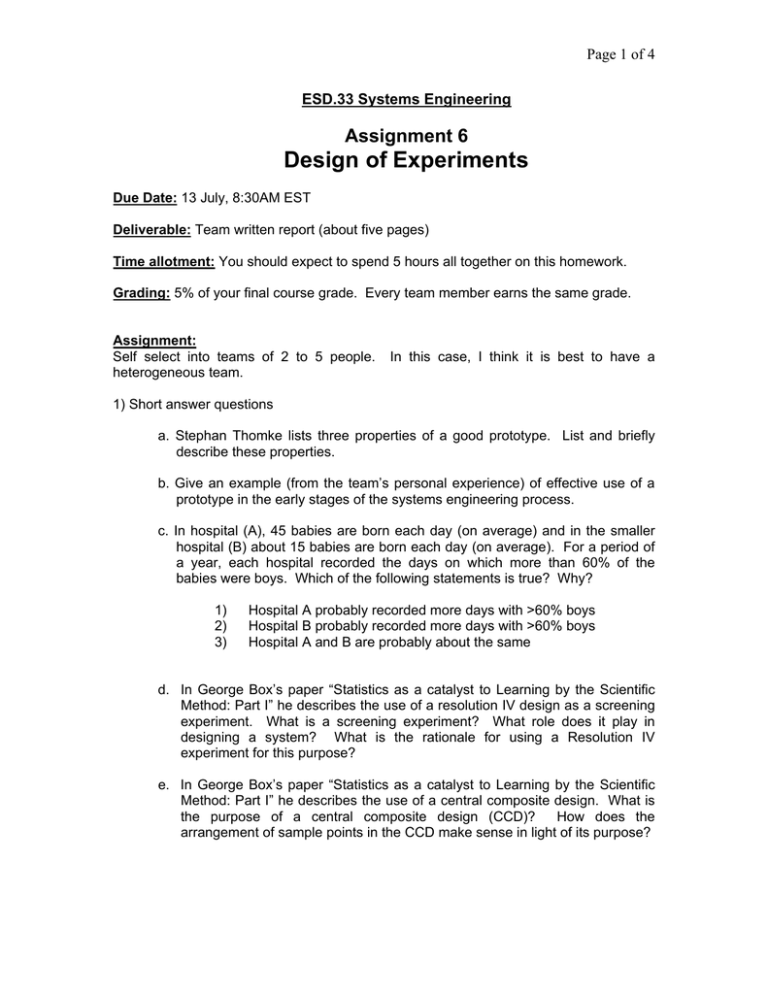1 2 The Basic Principles of DOE STAT 503
Table Of Content

Design of Experiments (DOE) is a branch of applied statistics focused on using the scientific method for planning, conducting, analyzing and interpreting data from controlled tests or experiments. DOE is a mathematical methodology used to effectively plan and conduct scientific studies that change input variables (X) together to reveal their effect on a given response or the output variable (Y). In plain, non-statistical language, the DOE allows you to evaluate multiple variables or inputs to a process or design, their interactions with each other and their impact on the output. In addition, if performed and analyzed properly you should be able to determine which variables have the most and least impact on the output. By knowing this you can design a product or process that meets or exceeds quality requirements and satisfies customer needs. The Design of Experiments (DoE) landscape is rich with diverse strategies tailored to uncover specific insights within various research domains.
Maximize process response
This Is for Everyone: Design Experiments for the Common Good - MoMA
This Is for Everyone: Design Experiments for the Common Good.
Posted: Thu, 29 Oct 2015 04:29:16 GMT [source]
Replication reinforces the integrity of the scientific method, allowing researchers to confidently attribute observed effects to the experimental conditions rather than to random variation. Within-subjects or repeated measures can also refer to an experimental design where an effect emerges over time, and individual responses are measured over time in order to measure this effect as it emerges. In a within-subjects design (also known as a repeated measures design), every individual receives each of the experimental treatments consecutively, and their responses to each treatment are measured. For valid conclusions, you also need to select a representative sample and control any extraneous variables that might influence your results. If if random assignment of participants to control and treatment groups is impossible, unethical, or highly difficult, consider an observational study instead.

Book traversal links for 1.2 - The Basic Principles of DOE
Advice on "Lack of fit" and "replicate" points for an I Optimal Design of Experiments? - ResearchGate
Advice on "Lack of fit" and "replicate" points for an I Optimal Design of Experiments?.
Posted: Mon, 16 May 2022 07:00:00 GMT [source]
However, the focus of the course is on the design and not on the analysis. In this course we will pretty much cover the textbook - all of the concepts and designs included. I think we will have plenty of examples to look at and experience to draw from.
A Quick Guide to Experimental Design 5 Steps & Examples
While there are several software programs available for DOE analysis, to properly apply DOE you need to possess an understanding of basic statistical concepts. Experimental research design should be used when a researcher wants to establish a cause-and-effect relationship between variables. It is particularly useful when studying the impact of an intervention or treatment on a particular outcome. Standard DoE processes are often structured around seven or fewer steps.
Blinding involves keeping participants, researchers, or both unaware of which treatment group participants are in, in order to reduce the risk of bias in the results. Laboratory experiments are conducted under controlled conditions, which allows for greater precision and accuracy. However, because laboratory conditions are not always representative of real-world conditions, the results of these experiments may not be generalizable to the population at large. In this design, each participant is exposed to all of the different treatments or conditions, either in a random order or in a predetermined order. FMCG industry is a part of consumer goods industry that includes all the products which are sold to the general public by any means such as retail stores, internet or by phone.
They ensure that experiments designed are technically sound, ethically grounded, and philosophically aligned with pursuing a deeper understanding of the world. If we categorize our subjects by gender, how should we allocate our drugs to our subjects? Let's make it easy and say that there are 10 male and 10 female subjects. A balanced way of doing this study would be to put five males on drug A and five males on drug B, five females on drug A and five females on drug B.
A richer understanding of biological complexity.
At the foundation, we have basic designs such as the completely randomized design and the randomized block design, which serve as the starting points for most experimental frameworks. At the heart of transformative research lies the Design of Experiments (DoE), a fundamental methodology that propels scientific inquiry to new heights of accuracy and insight. This approach not only refines the data collection and analysis process but also embodies the quest for discovering truths hidden within complex systems. The practice of Designing Experiments goes beyond mere data analysis; it is a philosophical commitment to enhancing the good by improving research methods and revealing the inherent beauty in data patterns. With each experiment designed, we step closer to insights that reflect the depth and richness of our reality, making DoE not just a technical necessity but a beacon of enlightenment in the scientific community. Experimental design provides a structured approach to designing and conducting experiments, ensuring that the results are reliable and valid.
Change the value of the one factor, then measure the response, repeat the process with another factor. Test different settings of two factors and see what the resulting yield is. 'I love to add boho elements to a home by mixing prints, experimenting with unexpected pops of color, and mixing and matching different styles of art,' adds Kathy Kuo.
Design of Experiments is a framework that allows us to investigate the impact of multiple different factors—changed simultaneously—on an experimental process. A perfect cup of tea depends on multiple other factors, such as the blend, brewing time, and the addition of sugar. In other words, making a perfect cup of tea is complex and multidimensional. DOE allows researchers to investigate the effect of changing multiple factors simultaneously. Some knowledge of statistical tools and experimental planning is required to fully understand DOE methodology.
In a within-subjects design, each participant experiences all conditions, and researchers test the same participants repeatedly for differences between conditions. In a between-subjects design, every participant experiences only one condition, and researchers assess group differences between participants in various conditions. How precisely you measure your dependent variable also affects the kinds of statistical analysis you can use on your data. How you manipulate the independent variable can affect the experiment’s external validity – that is, the extent to which the results can be generalised and applied to the broader world. Experimental design means creating a set of procedures to systematically test a hypothesis.
Much like the approach to decorating with color in a Bohemian scheme, there are no strict rules when choosing the right furnishings for your space. Rather, embrace an eclectic approach by mixing varying styles of furniture to add to the charm. Decorating with vintage is one of the easiest and most effective ways to do this. Bringing the outdoors into your Bohemian-style interior scheme is an important part of mastering the aesthetic.
This started what Montgomery calls a second Industrial Era, and sometimes the quality revolution. After the second world war, Japanese products were of terrible quality. The Japanese car industry adopted statistical quality control procedures and conducted experiments which started this new era. Total Quality Management (TQM), Continuous Quality Improvement (CQI) are management techniques that have come out of this statistical quality revolution - statistical quality control and design of experiments. Completely Randomized Design (CRD) is the simplest form of experimental design, where treatments are randomly assigned to experimental units.
Because one component of DoE is the settings of factors, performing an experimental runs are applicable here. Plus, we will we have support for different types of regression models. For example, we can estimate what we call a linear model, or an interaction model, or a quadratic model. So the selected experimental plan will support a specific type of model. If we take the approach of using three factors, the experimental protocol will start to define a cube rather than a rectangle. Next, we evaluate what will happen when we fix the volume at 550 ml (the optimal level) and start to change the second factor.
Comments
Post a Comment